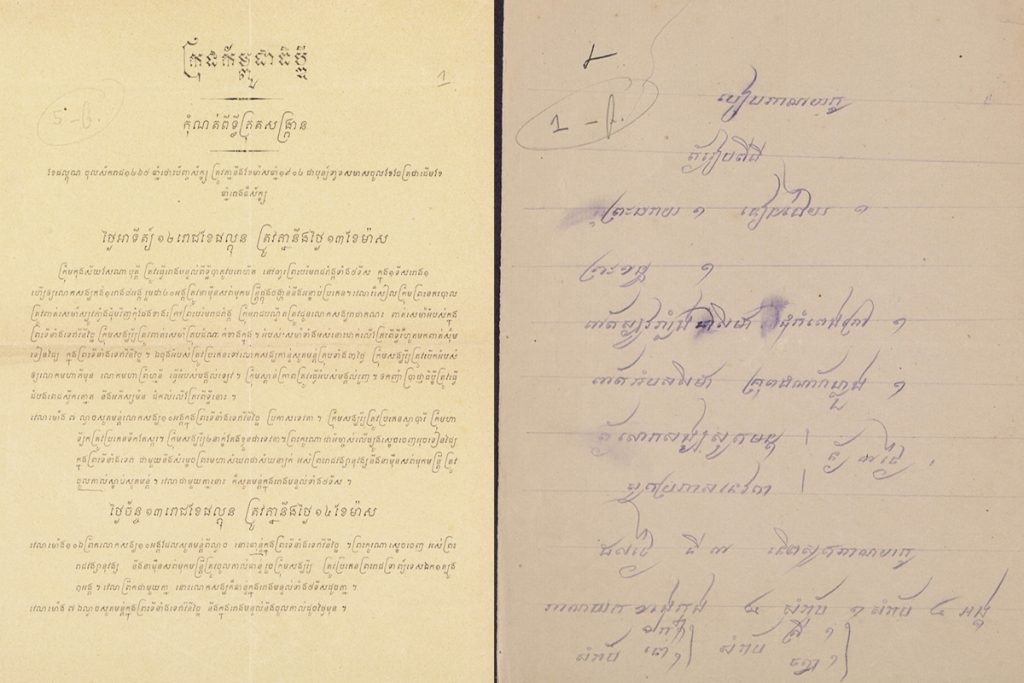មកទល់បច្ចុប្បន្ននេះ ខ្មែរយើងប្រើសករាជចំនួនបួន គឺមហាសករាជ ពុទ្ធសករាជ ចុល្លសករាជ និងគ្រិស្ដសករាជ។ ចាប់តាំងពីខ្មែរយើងមានភស្ដុតាងជាសំណេរមក យើងឃើញថាសករាជដែលខ្មែរដំបូងគឺ «មហាសករាជ» ដែលកាលដើមដំបូងបំផុត ប្រើត្រឹមតែពាក្យថា «ឝក» (សក) ប៉ុណ្ណោះ។ ចំពោះបុណ្យចូលឆ្នាំឬឆ្លងឆ្នាំនៃសករាជនីមួយៗ យើងឃើញមានពិធីធំៗចំនួនពីរ គឺបុណ្យពិសាខបូជា ដែលជាបុណ្យពុទ្ធសាសនាផង និងជាការឆ្លងឆ្នាំថ្មីនៃអាយុព្រះពុទ្ធសាសនាផង។ ចំណែកឯបុណ្យចូលឆ្នាំខ្មែរ ដែលតែងតែប្រារព្ធនៅអំឡុងខែមេសានោះ គឺជាបុណ្យឆ្លងនិងចូលឆ្នាំចុល្លសករាជ ពោលគឺគេប្ដូរចូលចុល្លសករាជថ្មីនៅក្នុងឱកាសនោះ។ ចំណែកឯ «មហាសករាជ» វិញ តើឆ្លងឬចូលឆ្នាំថ្មីនៅពេលណាដែរ? តើមានប្រារព្ធពិធីអ្វីឬទេ?
មហាសករាជ ចាប់កំណើតនៅប្រទេសឥណ្ឌា នៅថ្ងៃ១កើត ខែចេត្រ គ.ស.៧៨ ត្រូវនឹងថ្ងៃទី១៤ ខែមីនា គ្រិស្ដសករាជឆ្នាំ៧៨ ដោយឈ្មោះសករាជនេះ យកតាមព្រះនាមរបស់ព្រះបាទសក(ឝក)។ ប្រតិទិនរបស់មហាសករាជ គិតតាមដំណើរគោចររបស់ព្រះចន្ទ ឬ «ចន្ទគតិ»។ ដូច្នេះ កាលបើគិតពីឆ្នាំរបស់មហាសករាជ គេត្រូវគិតតាមថ្ងៃខែរបស់ចន្ទគតិ ពុំគិតតាមដំណើរសុរិយគតិឡើយ។ មហាសករាជថ្មី រមែងរាប់ចាប់ពីថ្ងៃ១កើត ខែចែត្រ ជារៀងរាល់ឆ្នាំ។ នៅប្រទេសកម្ពុជា ពិធីបុណ្យឆ្លងឬចូលឆ្នាំមហាសករាជ មនុស្សម្នាទូទៅហាក់ពុំបានដឹង និងពុំឃើញមានធ្វើជាទូទៅនោះឡើយ គឺមានប្រារព្ធពិធីជាពិសេសតែនៅក្នុងព្រះបរមរាជវាំងតែប៉ុណ្ណោះ។

ជារៀងរាល់ឆ្នាំ នាថ្ងៃ១២ ១៣ ១៤ និង១៥ រោច ខែផល្គុន នៅក្នុងព្រះបរមរាជវាំង តែងប្រារព្ធព្រះរាជពិធីមួយមានឈ្មោះថា «ព្រះរាជពិធីត្រស្ដិសង្ក្រាន្ត» ឬមានឈ្មោះហៅផ្សេងទៀតដូចជា៖ ព្រះរាជពិធីសូត្រភាណយក្ស ព្រះរាជពិធីបញ្ជាន់ត្រស្ដិ ព្រះរាជពិធីសម្ពច្ឆរច្ឆិន្ទ ដែលជាកិច្ចផ្ដាច់ឆ្នាំចាស់ ផ្លាស់ចូលឆ្នាំថ្មី។ កិច្ចត្រស្ដិសង្ក្រាន្ដនេះ ចប់នៅថ្ងៃ១៥រោច ខែផល្គុន ឯចាប់ពីថ្ងៃ១កើត ខែចែត្រតទៅ នឹងចូលឆ្នាំថ្មីនៃមហាសករាជហើយ។ ពាក្យ «ត្រស្ដិសង្ក្រាន្ដ» នេះមានន័យថា «ដំណើរផ្ដាច់ឆ្នាំចាស់ផ្លាស់ចូលឆ្នាំថ្មី»។ ព្រះរាជពិធីនេះដែលហៅម្យ៉ាងទៀតថាជា «ព្រះរាជពិធីសូត្រភាណយក្ស» ដ្បិតមានការសូត្រអាដានាដិយបរិត្តបណ្ដេញយក្ស ខ្មោចបិសាច។ ចំណែកឯពាក្យថា «បញ្ជាន់ត្រស្ដិ» គឺបញ្ជាន់បណ្ដេញខ្មោចបិសាចឆ្នាំចាស់ឱ្យបរវៀសជៀសឆ្ងាយទៅ។ នៅក្នុងព្រះរាជពិធីនេះ មានកិច្ចពិធីជាច្រើន ដែលយើងមិនលើកមកជជែកនៅទីនេះឡើយ ដ្បិតមានបរិយាយនៅក្នុងសៀវភៅ ព្រះរាជពិធីទ្វាទសមាស យ៉ាងក្បោះក្បាយរួចហើយ។

(ប្រភពឯកសារ៖ https://bibliotheque-numerique-patrimoniale.cu-alencon.fr/)
នៅក្នុងសៀវភៅព្រះរាជពិធីទ្វាទសមាសភាគទី៣ បានបញ្ជាក់ថា ចាប់ពីថ្ងៃទី១កើត ខែចែត្រ គឺចាស់បុរាណរាប់ថាជាឆ្នាំថ្មីហើយ ដោយគ្រាន់តែមិនទាន់ឡើងស័កប៉ុណ្ណោះ។ ឯកសារនេះ ពុំបានបញ្ជាក់ថាឆ្នាំថ្មីដែលឆ្លងនេះ ជាឆ្នាំថ្មីរបស់សករាជណាឡើយ។ យ៉ាងនេះក្ដី យើងដឹងដោយពិនិត្យលើកំណើតរបស់មហាសករាជ ឆ្នាំថ្មីនេះ គឺសំដៅដល់ឆ្នាំថ្មីរបស់មហាសករាជនោះឯង។ ចំណែកឯការដែលពុំទាន់ឡើងស័កនោះ ដ្បិតតែខ្មែរប្រើប្រាស់សករាជច្រើនដូចបានបញ្ជាក់មកស្រាប់។ យើងឃើញថា «មហាសករាជ» ត្រូវចូលឆ្នាំថ្មី ពីថ្ងៃ១កើត ខែចែត្រ ឯចុល្លសករាជ ត្រូវចូលឆ្នាំថ្មីអំឡុងបុណ្យចូលឆ្នាំខ្មែរ និងចំណែកឯពុទ្ធសករាជវិញ ត្រូវចូលឆ្នាំថ្មី នៅថ្ងៃ១រោច ខែពិសាខ។ ដូច្នេះឃើញថាសករាជទាំងបីនេះ ចូលឆ្នាំមុនក្រោយគ្នា ជាហេតុនាំឱ្យពិបាកក្នុងផ្លូវកិច្ចការរាជការ។ ដើម្បីសម្រួលដល់កិច្ចការនេះ ចាស់បុរាណយកមហាសករាជ ដែលឆ្លងចូលឆ្នាំថ្មីហើយនៅដើមខែចែត្រ និងពុទ្ធសករាជដែលនឹងឆ្លងចូលឆ្នាំថ្មីនៅពាក់កណ្ដាលខែពិសាខ មកឡើងសករាជរួមគ្នាជាមួយចុល្លសករាជ ដែលជាកាលវេលាខ្មែរប្រារព្ធពិធីបុណ្យចូលឆ្នាំថ្មីប្រពៃណីជាតិ។ ក្រោយៗមក ដោយគិតគត់មត់តាមត្រឹមត្រូវពេកទៅ ក៏នាំជាសេចក្ដីលំបាកដល់កិច្ចការរដ្ឋបាលដោយអន្លើ ដូចជាការរង់ចាំប្ដូរពុទ្ធសករាជដល់ថ្ងៃ១រោច ខែពិសាខ ជាដើម។ នៅក្នុងសៀវភៅសូរិយាត្រឡើងស័ករបស់លោក ពូវ អ៊ុម បានពន្យល់បញ្ជាក់យ៉ាងច្បាស់អំពីការលើកសករាជ និងភាពផ្សេងគ្នារវាង “ពុទ្ធសាសនា” និង “ពុទ្ធសករាជ”។ លោកបានពន្យល់ថា សករាជជាកំណត់រាប់ចំនួនឆ្នាំ គឺមួយឆ្នាំ សករាជឡើង១ សករាជឆ្នាំចាស់និងសករាជឆ្នាំថ្មីផ្លាស់គ្នា ត្រង់ថ្ងៃឡើងស័ក នៅវេលាដែលហោរាចុះក្នុងមហាសង្ក្រាន្ដ តែវេលាត្រង់ផុតសករាជឆ្នាំចាស់ដល់មកជារឿយៗ ខុសវេលាត្រង់វេលាថ្ងៃចែកគ្នា គឺកម្រត្រូវត្រង់វេលាអាធ្រាត្រដែលជាទីបំផុតថ្ងៃនោះឯង ជាហេតុនោះលោក(ចាស់បុរាណ)ឱ្យរាប់ថ្ងៃទី១ ក្នុងសករាជឆ្នាំថ្មី នៅថ្ងៃពីមុខថ្ងៃឡើងស័កតទៅ ព្រោះពុទ្ធសករាជក្ដី មហាសករាជក្ដី ចុល្លសករាជក្ដី បោករាណសករាជក្ដី សឹងរាប់ដូចគ្នា។ បើនឹងគិតពីពុទ្ធសករាជ ត្រូវគិតពេញតាំងពីថ្ងៃឡើងស័កតទៅ។ ប៉ុន្ដែបើនឹងគិតពី(អាយុ)ព្រះពុទ្ធសាសនា ត្រូវគិតពីថ្ងៃដែលព្រះអង្គបរិនិព្វានទៅ គឺពីថ្ងៃ១៥កើត ខែពិសាខ ឆ្នាំម្សាញ់ ឯកស័ក គឺគិតគត់ឆ្នាំ គត់ខែ គត់ថ្ងៃ ដែលត្រូវកំណត់យកនោះឯង។ ឧបមាដូចគ្នានឹងអាយុព្រះគ្រិស្ដ និងគ្រិស្ដសករាជទៅចុះ។ ខ្មែរយើងប្រកាន់ថា គ្រិស្ដសករាជ គឺគិតចាប់ពីព្រះគ្រិស្ដប្រសូត។ ព្រះគ្រិស្ដប្រសូតនៅថ្ងៃ២៥ ខែធ្នូ ប៉ុន្ដែគ្រិស្ដសករាជបែរជាលើកនៅថ្ងៃទី១ ខែមករា ជាឆ្នាំថ្មីទៅវិញ ពុំគិតរាប់ថាជាឆ្នាំថ្មីពីថ្ងៃទី២៥ ខែធ្នូនោះមកទេ៕
————————————–
New Year or New Mahāsakarāj
Khmer uses four Eras, Mahāsakarāj (Great Era), Buddhist Era (Before Christ), Culāsakarāj (Lesser Era), and Common Era (Christ Era). Since having the letter, Khmer has been using Mahāsakarāj. It was shortly written as Çaka. Khmer has two big ceremonies in every new year or new Sakarāj. They are Visakha Puja (Buddhist ceremony and a new year of Buddha). However, Khmer New Year which is usually celebrated in April is a crossing day ceremony and the entering of a new Culā year or Culāsakarāj. In contrast, when is a new Mahāsakarāj? Are there ceremonies?
Mahāsakarāj started in India on the Ket 1st of Caitra in 78 C.E. that is March 14th, 78 C.E. The word Mahāsakarāj came from the name of King Saka (Çaka). Mahāsakarāj refers to the movement of the moon (lunar). A new Mahāsakarāj is on the 1st Ket of Caitra annually. Generally, people do not do this ceremony because it does in the royal palace.
Annually, on the 12th, 13th, 14th and 15th of Phalguna, the royal palace celebrates a ritual called Preah Reach Pithi Tresh Sankranti or Preah Reach Pithi Sot Phea Nayak, Preah Reach Pithi Banchan Tresh, and Preah Reach Pithi Sampocharachhinda. It is a ritual to end the year and begin a new year. It is called Preah Reach Pithi Sot Phea Nayak because there is the chanting of a sermon that destroys Yaksa or bad spirit. The word Banchan Tresh refers to the act of removing or getting rid of the bad spirits from last year. This ritual has many activities and is mentioned in detail in the book called Tvea Tousameas (Dvadasamasa or 12 months). In the third edition of the book, Dvadasamasa says on the 1st Ket of Caitra, Culāsakarāj is a new year, but not yet changing the Saka. Significantly, this mention does not refer to any era. However, it refers to Mahāsakarāj. Also, why it is the new year but not Leung Saka (changing the year) because Khmer uses many eras. Remarkably, a new Mahāsakarāj will start on the 1st Ket of Caitra. However, a new Culāsakarāj will start on the 1st Roch of Visakha. The difference could bring a lot of confusion in the government work. To facilitate this issue, the elderly chose Mahāsakarāj to begin the new year, the early of Caitra, and the Buddhist era which begins in the mid of Visakha to change the year or Leung Sakarāj together with Culāsakarāj. It is when Khmer celebrate New Year. In a book published by Pov Oum, Soryatra clearly explains the shift of Saka and the difference between Buddhism and the Buddhist era. He explains Saka counts the number of years. One year, Saka increases one time. It is the changing between old and new Saka. The time of Leung Saka is in midnight. Therefore, it is decided to count the first day of a new Saka after the day of Leung Saka. Also, it is because Buddhist era, Mahāsakarāj, Culāsakarāj, Bokranasakarāj tends to count the same. However, if counting the age of Buddhism, it must be from the Buddha attained Nirvana which is the 15th Ket of Visakha, Msanh, Eka Saka. It is the same as the age of Christ and the common era. Khmer count the common era from the birth of Christ, December 25th. However, a new common era count from January 1st.
អត្ថបទដើម៖ លោក ហ៊ុន ឈុនតេង






